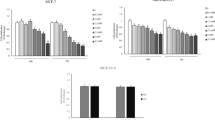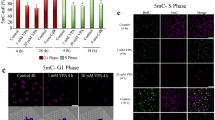Abstract
Acetylation of histone is a major player in epigenetic modifications, resulting in open chromatin structures and, hence, permissive conditions for transcription-factor recruitment to the promoters, followed by initiation of transcription. Histone deacetylase inhibitors arrest cancer cell growth and cause apoptosis with low toxicity thereby constituting a promising treatment for cancer. In this study, we examined the antiproliferative effects of valproate with a combination of nicotinamide in the MCF-7 cell line. MCF-7 was treated with various concentrations of valproate. The MTT assay showed that the viability of MCF-7 cells was inhibited and the cell activity was decreased. Viability percent of valproate and nicotinamide combined treatment cells (28 ± 2) was 1.78 times increased compared with the valproate-alone (0.5 mM) treated cells (50 ± 2). Colony formation in soft agar indicated that valproate at 0.3 mM, when used alone, weakly suppressed proliferation of cells (82 ± 3) and the combination treatment of valproate + nicotinamide strongly suppressed cell proliferation (51 ± 3). The flow cytometric and microscopic analyses of HDACI combined with treated cells indicated strong apoptosis induction and nuclear morphological alterations greater than those of valproate alone. Real-time reverse transcriptase-polymerase chain reaction (RT-PCR) analysis confirmed the efficiency of the HDAC inhibitor combination, revealing the effectively upregulated p16 and p21. Furthermore, to investigate the role of acetyl-histone H3 levels, western blot analyses have been performed and high levels of acetylated histone H3 were detected in valproate- and nicotinamide-treated cells. These results suggest that the combination treatment of valproate with nicotinamide exerts significant antitumor activity and could be a promising therapeutic candidate to treat human breast cancer.





Similar content being viewed by others
References
Alao JP, Stavropoulou AV, Lam EW, Coombes RC, Vigushin DM. Histone deacetylase inhibitor, trichostatin A induces ubiquitin-dependent cyclin D1 degradation in MCF-7 breast cancer cells. Mol Cancer. 2006;5:8.
Bozkurt E, Atmaca H, Kisim A, Uzunoglu S, Uslu R, Karaca B. Effects of Thymus serpyllum extract on cell proliferation, apoptosis and epigenetic events in human breast cancer cells. Nutr Cancer. 2012;64(8):1245–50.
Carew JS, Giles FJ, Nawrocki ST. Histone deacetylase inhibitors: mechanisms of cell death and promise in combination cancer therapy. Cancer lett. 2008;269(1):7–17.
Ageberg M, Rydstrom K, Relander T, Drott K. The histone deacetylase inhibitor valproic acid sensitizes diffuse large B-cell lymphoma cell lines to CHOP-induced cell death. Am J Transl Res. 2013;5(2):170–83.
Hsia DA, Tepper CG, Pochampalli MR, Hsia EY, Izumiya C, Huerta SB, et al. KDM8, a H3K36me2 histone demethylase that acts in the cyclin A1 coding region to regulate cancer cell proliferation. Proc Natl Acad Sci U S A. 2010;107(21):9671–6.
Ellis L, Atadja PW, Johnstone RW. Epigenetics in cancer: targeting chromatin modifications. Mol Cancer Ther. 2009;8(6):1409–20.
Ellis L, Pili R. Histone deacetylase inhibitors: advancing therapeutic strategies in hematological and solid malignancies. Pharmaceuticals (Basel). 2010;3(8):2411–69.
Emanuele S, Lauricella M, Tesoriere G. Histone deacetylase inhibitors: apoptotic effects and clinical implications (review). Int J Oncol. 2008;33(4):637–46.
Ward CS, Eriksson P, Izquierdo-Garcia JL, Brandes AH, Ronen SM. HDAC inhibition induces increased choline uptake and elevated phosphocholine levels in MCF7 breast cancer cells. PLoS One. 2013;8(4):e62610.
Jeong JB, Choi J, Lou Z, Jiang X, Lee SH. Patchouli alcohol, an essential oil of Pogostemon cablin, exhibits anti-tumorigenic activity in human colorectal cancer cells. Int Immunopharmacol. 2013;16(2):184–90.
Jung M, Kozikowski A, Dritschilo A. Rational design and development of radiation-sensitizing histone deacetylase inhibitors. Chem biodivers. 2005;2(11):1452–61.
Noro R, Miyanaga A, Minegishi Y, Okano T, Seike M, Soeno C, et al. Histone deacetylase inhibitor enhances sensitivity of non-small-cell lung cancer cells to 5-FU/S-1 via down-regulation of thymidylate synthase expression and up-regulation of p21(waf1/cip1) expression. Cancer Sci. 2010;101(6):1424–30.
Souto JA, Conte M, Alvarez R, Nebbioso A, Carafa V, Altucci L, et al. Synthesis of benzamides related to anacardic acid and their histone acetyltransferase (HAT) inhibitory activities. ChemMedChem. 2008;3(9):1435–42.
Bug G, Ritter M, Wassmann B, Schoch C, Heinzel T, Schwarz K, et al. Clinical trial of valproic acid and all-trans retinoic acid in patients with poor-risk acute myeloid leukemia. Cancer. 2005;104(12):2717–25.
Franci G, Miceli M, Altucci L. Targeting epigenetic networks with polypharmacology: a new avenue to tackle cancer. Epigenomics. 2010;2(6):731–42.
Bartels M, Geest CR, Bierings M, Buitenhuis M, Coffer PJ. Histone deacetylase inhibition modulates cell fate decisions during myeloid differentiation. Haematologica. 2010;95(7):1052–60.
Blum W, Klisovic RB, Hackanson B, Liu Z, Liu S, Devine H, et al. Phase I study of decitabine alone or in combination with valproic acid in acute myeloid leukemia. J Clin Oncol : off J Am Soc Clin Oncol. 2007;25(25):3884–91.
Kuendgen A, Gattermann N. Valproic acid for the treatment of myeloid malignancies. Cancer. 2007;110(5):943–54.
Kuendgen A, Knipp S, Fox F, Strupp C, Hildebrandt B, Steidl C, et al. Results of a phase 2 study of valproic acid alone or in combination with all-trans retinoic acid in 75 patients with myelodysplastic syndrome and relapsed or refractory acute myeloid leukemia. Ann Hematol. 2005;84 Suppl 1:61–6.
Morotti A, Cilloni D, Messa F, Arruga F, Defilippi I, Carturan S, et al. Valproate enhances imatinib-induced growth arrest and apoptosis in chronic myeloid leukemia cells. Cancer. 2006;106(5):1188–96.
Federico M, Bagella L. Histone Deacetylase Inhibitors in the Treatment of Hematological Malignancies and Solid Tumors. J Biomed Biotechnol. 2011;2011
Bouzar AB, Boxus M, Defoiche J, Berchem G, Macallan D, Pettengell R, et al. Valproate synergizes with purine nucleoside analogues to induce apoptosis of B-chronic lymphocytic leukaemia cells. Br J Haematol. 2009;144(1):41–52.
Finkel T, Deng CX, Mostoslavsky R. Recent progress in the biology and physiology of sirtuins. Nature. 2009;460(7255):587–91.
Galli M, Van Gool F, Rongvaux A, Andris F, Leo O. The nicotinamide phosphoribosyltransferase: a molecular link between metabolism, inflammation, and cancer. Cancer Res. 2010;70(1):8–11.
Byles V, Zhu L, Lovaas JD, Chmilewski LK, Wang J, Faller DV, et al. SIRT1 induces EMT by cooperating with EMT transcription factors and enhances prostate cancer cell migration and metastasis. Oncogene. 2012;31(43):4619–29.
Cea M, Cagnetta A, Gobbi M, Patrone F, Richardson PG, Hideshima T, et al. New insights into the treatment of multiple myeloma with histone deacetylase inhibitors. Curr Pharm Des. 2013;19(4):734–44.
Rezaei PF, Fouladdel S, Hassani S, Yousefbeyk F, Ghaffari SM, Amin G, et al. Induction of apoptosis and cell cycle arrest by pericarp polyphenol-rich extract of Baneh in human colon carcinoma HT29 cells. Food Chem toxicol : Int J publ Br Ind Biol Res Assoc. 2012;50(3–4):1054–9.
Hafizi M, Bakhshandeh B, Soleimani M, Atashi A. Exploring the enkephalinergic differentiation potential in adult stem cells for cell therapy and drug screening implications. In vitro cellular & developmental biology – Animal. 2012;48(9):562–9.
Zhang Y, Yu G, Wang D, Hu Y, Lei W. ERK1/2 activation plays important roles in the opposite effects of Trichostatin A in non-cancer and cancer cells. Toxicon : Off J Int Soc Toxinol. 2011;57(6):932–7.
Azad N, Zahnow CA, Rudin CM, Baylin SB. The future of epigenetic therapy in solid tumours—lessons from the past. Nat Rev Clin Oncol. 2013;10(5):256–66.
Adwan L, Zawia NH. Epigenetics: a novel therapeutic approach for the treatment of Alzheimer’s disease. Pharmacol Ther. 2013;139(1):41–50.
Koutsounas I, Giaginis C, Patsouris E, Theocharis S. Current evidence for histone deacetylase inhibitors in pancreatic cancer. World J Gastroenterol : WJG. 2013;19(6):813–28.
Byler TK, Leocadio D, Shapiro O, Bratslavsky G, Stodgell CJ, Wood RW, et al. Valproic acid decreases urothelial cancer cell proliferation and induces thrombospondin-1 expression. BMC Urol. 2012;12:21.
Cho YK, Eom GH, Kee HJ, Kim HS, Choi WY, Nam KI, et al. Sodium valproate, a histone deacetylase inhibitor, but not captopril, prevents right ventricular hypertrophy in rats. Circ J : Off J Jap Circ Soc. 2010;74(4):760–70.
Ververis K, Hiong A, Karagiannis TC, Licciardi PV. Histone deacetylase inhibitors (HDACIs): multitargeted anticancer agents. Biol: Targets Ther. 2013;7:47–60.
Koutsounas I, Giaginis C, Theocharis S. Histone deacetylase inhibitors and pancreatic cancer: are there any promising clinical trials? World J Gastroenterol : WJG. 2013;19(8):1173–81.
Hrebackova J, Hrabeta J, Eckschlager T. Valproic acid in the complex therapy of malignant tumors. Curr Drug Targets. 2010;11(3):361–79.
Cea M, Soncini D, Fruscione F, Raffaghello L, Garuti A, Emionite L, et al. Synergistic interactions between HDAC and sirtuin inhibitors in human leukemia cells. PLoS ONE. 2011;6(7):e22739.
Acknowledgments
The authors would like to acknowledge the financial support of the Research Council of the University of Tehran and the Stem Cell Technology Research Center.
Author information
Authors and Affiliations
Corresponding authors
Rights and permissions
About this article
Cite this article
Jafary, H., Ahmadian, S. & Soleimani, M. The enhanced apoptosis and antiproliferative response to combined treatment with valproate and nicotinamide in MCF-7 breast cancer cells. Tumor Biol. 35, 2701–2710 (2014). https://doi.org/10.1007/s13277-013-1356-0
Received:
Accepted:
Published:
Issue Date:
DOI: https://doi.org/10.1007/s13277-013-1356-0




